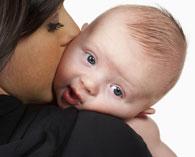-
(单词翻译:双击或拖选)
Washington
24 May 2007
Scientists have always thought that babies learn language by hearing them, but a new study provides evidence that infants as young as four months can distinguish between different languages being spoken by using visual cues. VOA's Jessica Berman reports.
 |
Investigators1 say babies do this by studying the shapes and rhythm of mouth and facial movements.
"A lot of studies have just addressed the auditory properties of speech and so we were just interested to see whether this visual information is playing any sort of a role when babies are learning to perceive language," said researcher Whitney Weikum, who is with the University of British Columbia in Canada.
Weikum and colleagues studied four, six and eight-month-old infants from both monolingual English homes, and bilingual households where both English and French is spoken.
Each group of babies was shown silent video clips of three bilingual French-English speakers, who mouthed sentences first in one language and then in the other. Then the speakers switched languages.
Weikum says investigators found that babies who are raised in English-speaking homes could distinguish English and French at four and six months of age by staring intently at the videos. But by eight months, they became fidgety and paid less attention to the images.
At the same time, eight-month-old infants raised in bilingual households maintained their ability to distinguish between French and English by staring at the speaker.
Researchers concluded that babies raised in English-only households lost their ability to discriminate2 language based on visual cues because they no longer needed them, while infants in bilingual homes continued to depend on visual cues to discern which language was being spoken.
Weikum says the study is the first to show the importance of visual information in infants' language development.
"It says that very early on in infancy3 they are prepared to discriminate multiple languages just using visual cues, and depending upon their experience with visual cues, they either maintain or experience a decline in their ability to discriminate the language visually," said Weikum.
The study was published this week in the journal Science.
 收听单词发音
收听单词发音
1
investigators

|
|
| n.调查者,审查者( investigator的名词复数 ) | |
参考例句: |
|
|
|
2
discriminate

|
|
| v.区别,辨别,区分;有区别地对待 | |
参考例句: |
|
|
|
3
infancy

|
|
| n.婴儿期;幼年期;初期 | |
参考例句: |
|
|
|















